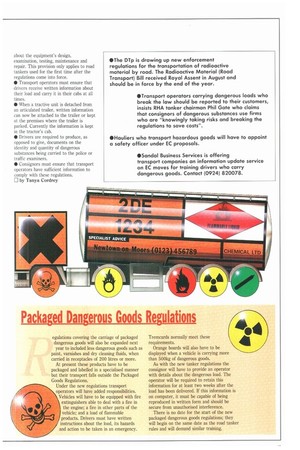Packaged Dangerous Goods Regulations
Page 47

If you've noticed an error in this article please click here to report it so we can fix it.
egulations covering the carriage of packaged dangerous goods will also be expanded next year to included less dangerous goods such as paint, varnishes and dry cleaning fluids, when carried in receptacles of 200 litres or more.
At present these products have to be packaged and labelled in a specialised manner but their transport falls outside the Packaged Goods Regulations.
Under the new regulations transport operators will have added responsibilities. Vehicles will have to be equipped with fire extinguishers able to deal with a fire in the engine; a fire in other parts of the vehicle; and a load of flammable
/ products. Drivers must have written instructions about the load, its hazards and action to be taken in an emergency. Tremcards normally meet these requirements.
Orange boards will also have to be displayed when a vehicle is carrying more than 500kg of dangerous goods.
As with the new tanker regulations the consignor will have to provide an operator with details about the dangerous load. The operator will be required to retain this information for at least two weeks after the load has been delivered. If this information is on computer, it must be capable of being reproduced in written form and should be secure from unauthorised interference.
There is no date for the start of the new packaged dangerous goods regulations; they will begin on the same date as the road tanker rules and will demand similar training.
















































































































